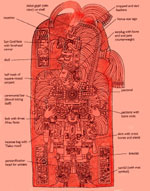
 |
John Pohl's MESOAMERICA |
|||||||
|
MAJOR ARCHAEOLOGICAL SITES: PreClassic to PostClassic TIKAL (circa A.D. 200-800) At the same time that Teotihuacán was emerging to dominate the Basin of México, powerful Maya city states were expanding throughout the lowland jungles of Central America. Drawing upon both an earlier tradition of monumental architecture from the PreClassic titans to the north, El Mirador and Nakbé, and an incipient writing system developed in the southern highlands, Maya lords not only constructed stunning pyramids, temples, and palace complexes but also commemorated major events in their reigns with hieroglyphic texts carved on stone monuments now called stelae. The most enduring of all Classic Maya ceremonial centers was Tikal. Founded during the PreClassic, Tikal later emerged at the end of the third century A.D. to dominate an intricate web of surrounding chiefdoms eventually becoming a metropolis of over 60,000 people at its height in A.D. 700. To establish a divine monument to their ancestors, Tikal’s rulers constructed a massive necropolis of superimposed tombs and towering temples until their fortunes took a turn for the worse at the hands of two rival states: Caracol and Calakmul. A hiatus in construction ensued but lasted less than a century before the great warlord, Hasaw Kan K’awil re-established the city’s hegemony. Tikal then continued to dominate political affairs throughout the Central Petén until the end of the ninth century when the city was abandoned during the so-called Maya “collapse”. Nevertheless, because the site represents the longest continuous occupation of any major Classic Maya ceremonial center, Tikal continues to be employed by archaeologists as the “anchor” for their excavations and epigraphic studies throughout the Central Petén.
|
||||||||
|
Text links to all pages at this site are available at the FAMSI INDEX |
||||||||


